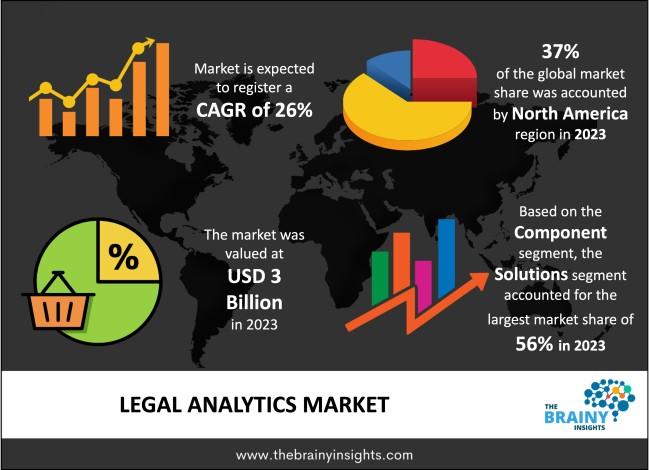
1. Market Overview
The Legal Analytics Market refers to the use of data analytics in the legal sector to improve decision-making, predict case outcomes, assess risks, and enhance the efficiency of legal operations. This market has witnessed rapid growth, driven by the increasing adoption of technology in law firms, courts, and legal departments of corporations. Legal analytics tools leverage AI, machine learning, and big data to analyze legal documents, predict litigation results, and provide insights into legal strategies.
The global legal analytics market was valued at USD 3 billion in 2023 and is projected to grow at a compound annual growth rate (CAGR) of 26% from 2024 to 2033, reaching an estimated USD 10.25 billion by 2033.
2. Market Dynamics
- Drivers:
- Increased Demand for Legal Efficiency: The growing pressure to reduce legal costs and enhance operational efficiency is pushing firms toward automation and analytics tools.
- AI and Big Data Technologies: Advancements in AI, machine learning, and data analytics are providing more accurate predictions and insights for legal professionals.
- Cost Reduction in Legal Operations: Analytics allows firms to optimize their resources, leading to a reduction in operational costs.
- Restraints:
- High Initial Investment: The adoption of legal analytics requires significant investment in technology, which might deter smaller firms from adopting these tools.
- Data Privacy and Security Concerns: Handling sensitive legal data with analytics raises concerns regarding privacy and the protection of client information.
- Opportunities:
- Integration with Other Legal Tech Solutions: There's an opportunity for integrating legal analytics tools with other legal technologies, such as document management systems and e-discovery tools, to enhance functionality.
- Growth in Corporate Legal Departments: With legal teams in large corporations seeking more cost-effective and efficient ways to handle legal matters, there’s a significant growth potential in this sector.
- Challenges:
- Regulatory and Ethical Issues: The use of AI in legal predictions and decision-making raises ethical concerns, particularly around bias and fairness in algorithms.
3. Regional Analysis
- North America is the largest market for legal analytics, primarily due to the high adoption of advanced technologies, a large number of law firms, and a supportive regulatory environment.
- Europe follows closely, with an increasing demand for legal analytics in the UK, Germany, and France. The region is also focusing on data privacy laws like GDPR, which impact the development of analytics tools.
- Asia Pacific is witnessing rapid growth due to the growing legal industry in countries like India, China, and Japan, as well as the increasing number of law firms adopting legal tech.
- Middle East and Africa are still emerging markets for legal analytics but are expected to see growth due to technological advancements and an expanding legal sector.
4. Segmental Analysis
- By Component:
- Software: This is the largest segment, driven by the widespread adoption of legal analytics software by law firms and legal departments.
- Services: Consulting, integration, and training services are crucial to ensure effective implementation and use of legal analytics tools.
- By Application:
- Litigation Analytics: Used for predicting case outcomes, analyzing legal precedents, and determining litigation strategies.
- Contract Analytics: Helps in contract review, management, and analysis for better compliance and risk management.
- Regulatory & Compliance Analytics: Assists companies in maintaining compliance with regulations and legal standards.
- By End-User:
- Law Firms: The largest segment, as law firms use analytics for case management, legal research, and strategy development.
- Corporate Legal Departments: These departments are increasingly adopting legal analytics to streamline in-house legal operations.
- Government & Regulatory Agencies: Utilized to predict legal outcomes and improve judicial decision-making.
5. List of Key Players
- Thomson Reuters
- LexisNexis
- Relativity
- RAVN Systems
- Everlaw
- Premonition
- Logikcull
- Deloitte
- Kira Systems
- CaseText
6. Key Trends
- Artificial Intelligence Integration: The incorporation of AI in legal analytics tools for better predictions, case analysis, and risk assessments.
- Cloud Adoption: Many legal analytics tools are being hosted on the cloud, enabling easier access, scalability, and cost-effectiveness for users.
- Predictive Analytics: Growing use of predictive analytics to forecast legal outcomes and trends in litigation.
- Increased Collaboration Across Sectors: Law firms and legal tech companies are collaborating with data analytics companies to bring advanced technology solutions to the legal field.
Request PDF Brochure: https://www.thebrainyinsights.com/enquiry/sample-request/14572
Conclusion
The Legal Analytics Market is poised for significant growth as the legal sector embraces digital transformation. With increasing adoption of AI and machine learning, law firms and legal departments are gaining valuable insights that enhance efficiency, decision-making, and case outcomes. However, the market also faces challenges related to high costs, ethical concerns, and data security. Regional growth is particularly strong in North America, Europe, and the Asia Pacific, with key players continuing to innovate and lead the market.
